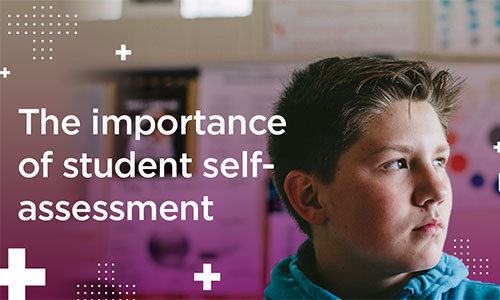
Every year, educators come together at the NWEA Fusion conference to talk shop: how to best support teachers, grow students, and learn from our collective years of experience. We share feelings, anecdotes, tips, tricks, and cautionary tales. But our main obsession, the piece that proves the efficacy of initiatives, curriculum changes, and new implementations? Our real keynote speaker, autograph signer, conference swag star? Data. We know, we’re nerdy like that. And every year, we nerd out together. Because we know how important it is for schools to have a positive data culture.
At Fusion 2024, we got a data download with one such nerd, Marcus Fryatt, director of assessment for Park Hill School District in Kansas City, Missouri. Park Hill is on an impressive journey of using regularly scheduled data check-ins: protected time to deep dive into academic data. Marcus makes sure these check-ins occur regularly and generate actionable plans that all educators feel ownership of.
But beyond explaining what comprises an effective data check-in, Marcus shares that successful data implementation begins and ends with a positive data culture. Ready to hear from him? Watch our conversation with Marcus to hear more about his passion for patience.
Need a playbook? We’ve distilled five steps for education leaders to implement Marcus’s data-driven vision in their school or district here.
Step 1: Break the data into manageable pieces
Supporting teachers on their data literacy journey doesn’t have to be overwhelming. It’s all about making data feel approachable. Instead of handing over vast data sets that can feel like insurmountable mountains, why not start with a few manageable hills?
Marcus and I hereby give you permission to start with a single data point—or, if you test with MAP® Growth™ or MAP® Reading Fluency™, a single report. (For more on MAP Growth reports and MAP Reading Fluency reports, visit our MAP Help Center.) Let that single data point or report be the only thing your team focuses on for a set period, like a semester or a year. It can be tempting to investigate more, zooming in and out, but mastering one data point or report at a time pays long-term dividends when the team is ready to branch out.
By presenting data in bite-sized portions, you are empowering your teachers to:
- Focus on one aspect at a time, avoiding overwhelm
- Begin to see data as a story that paints a bigger picture over time
- Have time and space to implement data-driven instructional changes—and see the ripples of those changes within the data itself
Leaders, it’s essential to explicitly signal to teachers that they don’t have to master all reports. Encourage them to stay focused on a single data set for a given period. This is a powerful way to get started building a positive data culture.
Step 2: Protect recurring data check-ins
Marcus has pioneered Park Hill’s data check-ins, which occur three times a year with building leaders and are reserved for talking about academic data only. Marcus says, “There is an infinite amount of data we’re able to provide our schools, but this time is purely dedicated to academic information based on NWEA Growth data.”
In these meetings, Marcus, building and instructional leaders, and classroom teachers dive into the pure academic data. They discuss what story the data is telling and plan a “theory of action”—a structure for understanding what changes and shifts need to occur in response to the data. At that point, Marcus’s district-level job is to provide resources and support to bolster that individual school’s plan.
But for this to happen, Marcus underscores three components that must be in place. He explains that the time for these data conversations must be:
- Protected. Time will not find itself. Data check-ins must be prioritized and marked as non-negotiable on the calendar.
- Predictable. No one should have to ask when data is going to be discussed and put to use. Get a recurring appointment going, even if you’re unsure of where to start.
- Pointed. Keep the focus of these meetings on academic data only. There are countless other data points, anecdotes, and observations that can add noise. Keep the signal pointed at the purely academic growth data.
Step 3: Shift everyone’s mindset from achievement to growth
“The idea is not, ‘I need every kid at a certain achievement level,’” Marcus explains. “The idea is, ‘What am I doing to help students grow?’”
If you’ve been around NWEA’s corner of the internet, you know we’re all about growth. But it’s one thing to idealize, and it’s quite another to implement. In Marcus’s experience, he advocates for district leaders to change their language to emphasize growth as the only measurement teachers should invest in. This is critical to building a positive data culture.
Many teachers have an internalized fear about test scores being weaponized against them, despite NWEA and education leaders acknowledging the myriad factors that compose a test score. Teachers worry that they won’t get students where they “should” be, joylessly catapulting themselves through their curriculum to achieve test scores. This, we all agree, benefits no one.
Leaders, as you clearly and transparently encourage a positive data culture and a mindset shift toward growth rather than achievement, take that as an opportunity to directly reassure teachers that their focus is not on rectifying years of a student’s “shoulds.” Marcus advocates for a culture shift—even one that takes years—that starts at the top and allows teachers to focus on one mission: “My job as a teacher is to help students grow.”
Step 4: Focus on relationships
It can be tempting to picture a data-driven culture as one of cold, hard science and numbers. This, folks, is mythology. Data is what’s on the page, but the act of data interpretation, strategy, planning, and follow-through is solely in the hands of people: people with dreams, families, emotions, tempers, fears, and big ol’ soft spots. From our youngest students to our tenured faculty members, this is about people.
Relationships inside a school are a waterfall. Their trickle-down effect starts in the office and ends in the backpack. Are our kids carting around district baggage about failure, passed to them from dejected teachers? Or do our kids feel successful and cared for because our teachers feel respected, supported, and recognized as human beings? Do district leaders, many of whom were once teachers themselves, still feel connected to the joy of a classroom “aha”moment?
It’s possible to prioritize data as an objective compass while driving change through relational compassion. And often, it’s just about reminding the team of who’s at the bottom of the waterfall: our kids.
Step 5: Embrace the slow pace
At one point in our conversation, Marcus takes a deep breath. “It’s like writing a dissertation,” he says. “You have to get something down on paper first.”
No matter your role in education, you know that big changes take time, and that their difficulty is just part of the process. No one knows better than educators, whether they’re classroom teachers or district leaders, that you just have to “rip the Band-Aid off,” as Marcus says.
A glorious part of the profession is that success, like a student’s career, is measured in years, not days. Year one isn’t going to be perfect. Year two isn’t going to be, either! As Marcus reminds us, “Just like teaching, it’s a never-ending process. We continue to search for new ways to help each of our teachers support each of our students. That’s the goal.” So stay the course, and your efforts toward building a positive data culture will pay off in the end.







